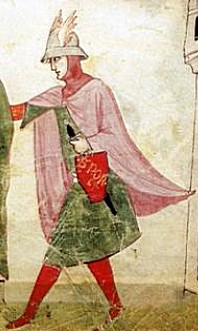Merkur

- Merkur should not be confused with Merkur Solingen, a subsidiary of DOVO Solingen.
Merkur, the German word for Mercury, was an automobile brand which was briefly marketed by Ford Motor Company in the United States and Canada from 1985 to 1989. Sold through selected Lincoln-Mercury dealers, Merkurs were in fact, German-built Fords (there was no Merkur or Mercury brand in Germany) and were thus a form of captive import. However, Merkur was the only division of the Ford Motor Company to be phased out. Advertising and PR materials strongly urged the proper German pronunciation, "mare-coor," but practically no one used it and the cars were generally called "Merker"s. Below the Merkur badge, was a script stating "FORD WERKE AG-Cologne, West Germany", stating the car's place of manufacture.
Like the Capri before it, the Merkur was Ford's attempt at selling a European car in the American market. However, due to the number of changes to meet federal regulations, the cars were manufactured by Karmann in Germany, the bodies coming from the Ford plant in Genk, Belgium, and the turbocharged engine for the XR4Ti from the Ford plant in Taubate, Brazil.

Only two models were sold under the Merkur badge — a performance-oriented 3-door hatchback version of the Ford Sierra XR4i called the Merkur XR4Ti (1985-1989), and the Merkur Scorpio (1988-1989), which was an American version of the Ford Scorpio 5-door hatchback. Neither model was particularly successful in Ford North America's eyes. Exchange rate fluctuations were one explanation; another was the generally odd styling and peculiar name. Also, the Scorpio bore a strong resemblance to the similarly-sized Mercury Sable, which was sold on the same showroom floors and was considerably cheaper.
It is interesting to contrast the relative failure of the Merkur vehicles compared to the success of the European versions. The Sierra was introduced as a replacement for the aging Ford Cortina, which was a bold move at the time considering the Cortina was one of Fords best selling cars. Despite initial misgivings about the styling, Sierra went on to be the second best selling car in Europe, second only to Fords own Escort. European Sierras were available in 3-door hatchback, 5-door hatchback, 4-door sedans, 5-door station wagons, and even a pickup truck called the P100. Engines were available from a 1.3 litre 60 hp 4 cylinder, to a 160 hp 2.8 litre V6, or a 2 litre, 16 valve, turbocharged and intercooled 4 cylinder as fitted to the mighty Sierra Cosworth. Fuel efficient models such as the 1.6 Economy could do 51 mpg imperial (5.5 L/100 km, 42 mpg U.S.) at a steady 56 mph (90 km/h), 30 mpg (l9.4 L/100 km, 25 mpg U.S.) simulated urban driving (British government test figures), or at the other end of the spectrum the Sierra Cosworth would do 0-60 mph in 6.2 seconds and go on to a top speed of almost 150 mph (and still capable of over 20 mpg imperial or 17 mpg U.S. or less than 14 L/100 km if driven gently).
Like the Sierra, the Scorpio was also available in a 4 door sedan and a 5 door wagon, although not at first. An "executive express" in the form of the Scorpio Cosworth was produced, powered by a 2.9 litre, 24 valve Cosworth V6 motor. This featured 16" aluminum alloy wheels similar to the AMG Mercedes wheels, a rear spoiler, and additional ground effects.
Before Ford pulled the plug, there were rumors that it would begin sourcing South American-made Sierras, but nothing came of this. There are accounts of a 16 valve 4 cylinder turbocharged version that was in prototype stage as well. This engine was never produced.
Merkurs have not so far generated much interest in the collector market, although their relative rarity could change that in the future. Several active owner communities exist, and parts can still generally be found, although some may have to be sourced from Europe. The XR4Ti shares its engine with the Mustang SVO and the Thunderbird Turbo Coupe, making it easier for owners to keep their cars running.
